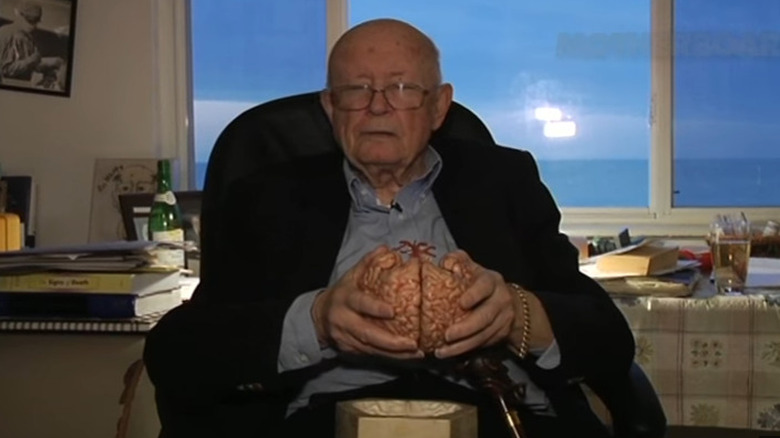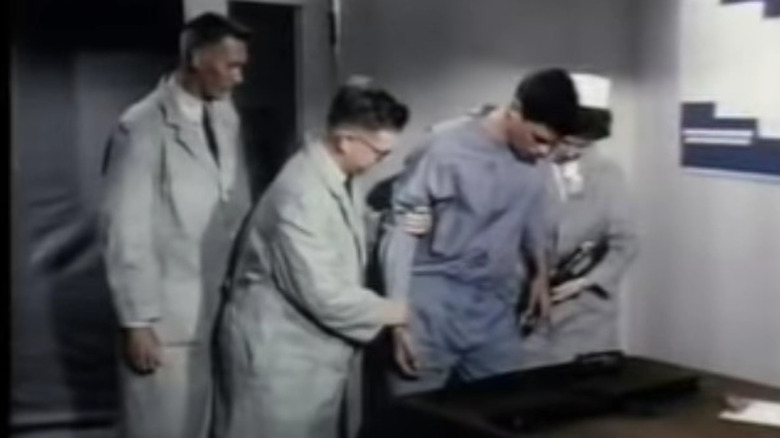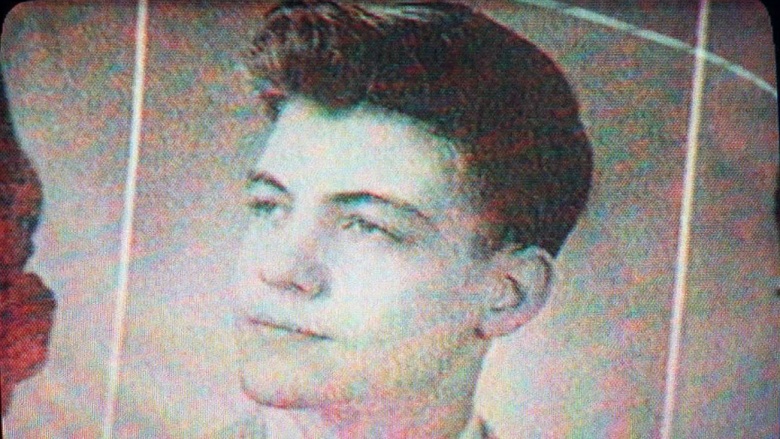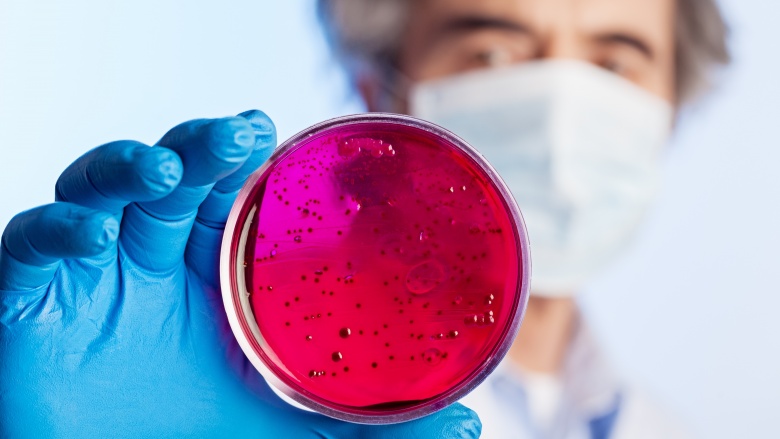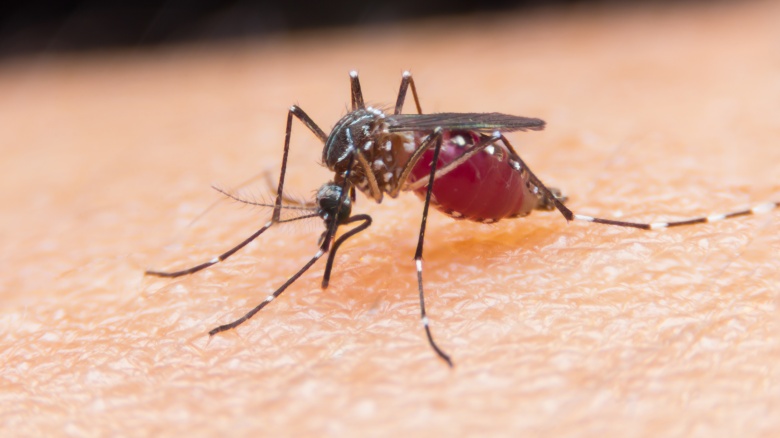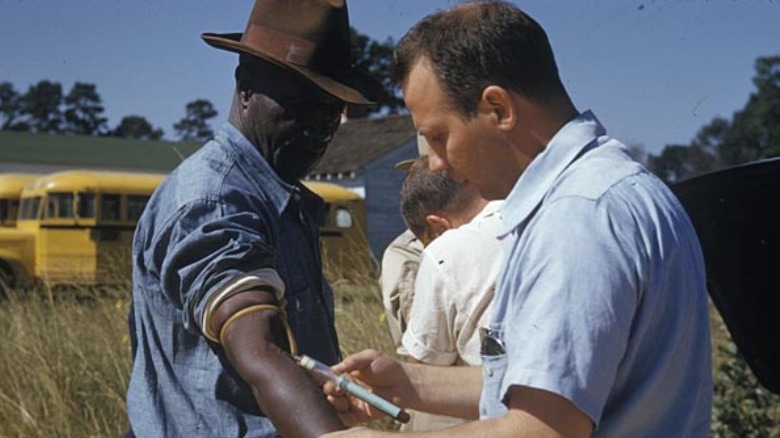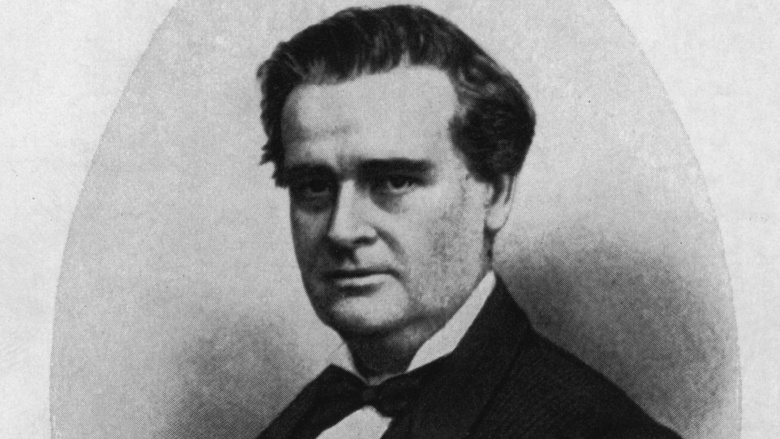Disturbing Secret Science Experiments That Actually Happened
Scientists are genuine heroes. After all, they've solved some of the world's biggest problems with discoveries and inventions like pasteurization, X-ray machines, and air conditioning. But science definitely has its dark side. Unchecked by ethics, researchers can take their studies and experiments in some very disturbing directions.
From freaky transplants and biological attacks to mind control and illicit drug experiments, here are some disturbing secret science experiments that actually happened.
The monkey head transplant
Dr. Robert J. White was obsessed with brains. A neurosurgeon operating out of Cleveland, White once said (via Cleveland.com), "I believe the brain tissue is the physical repository for the human soul." This obsession with the mind led White to some pretty weird places, turning him into a 20th-century mad scientist.
White's journey into scientific infamy started in the 1950s, when a Russian scientist named Vladimir Demikhov grafted the head of a dog onto the body of another dog, thus creating a two-headed mutt. Obviously, this stirred up some debate in the science community, but White took it as a challenge. In 1965, White surgically attached six dog brains into the necks of living canines. Next, he removed a monkey's brain and kept it working for 12 hours outside of a body.
But White wasn't finished grossing people out just yet. He had one last ghoulish trick up his sleeve. In 1970, White went full-Frankenstein, taking the head of a rhesus monkey and attaching it to a headless primate body. While it was too difficult to fuse the spinal columns together, the brain was perfectly functional, and the animal could taste, see, and hear. According to varying accounts, White kept his monster alive for somewhere between three and nine days.
Obviously, animal rights activists were infuriated with White's experiments, but the man did pioneer new ways of preserving brains during surgery. Plus, he won the respect of the Russians, clearly the ultimate goal of every red-blooded American. The Soviets were so impressed with his monkeys, they invited him over to check out their decapitated dogs in what had to be the most disgusting party of all time.
The Green Run
If you've ever seen an old-timey sci-fi movie, you know it's a bad idea for scientists to play around with radioactivity. They might create a giant monster, morph into an abominable creature, or accidentally threaten everyone in their community by launching an incredibly irresponsible experiment.
The latter's exactly what happened in December 1949 at the Hanford Site, a nuclear production complex in Washington state. Hanford was the plant that churned up enough plutonium to make Fat Boy, the atomic bomb dropped on Nagasaki. In other words, this was the perfect spot to run a top-secret radioactive experiment. On December 2, scientists decided it'd be a swell idea to release iodine-131 into the air, to see if the United States military could detect the presence of "green fuel" from a distance. What's green fuel, you ask? Normally, uranium fuel is cooled for about 100 days. That way, the radioactive iodine will fade away. But if you only cool it for 16 days, then it's still incredibly radioactive, aka "green."
Now, the U.S. government worried the Soviets were using green fuel to build their bombs faster, so they needed to know if their instruments could pick up on radioactive iodine. That way, they could determine if the Russians were taking the lead in the nuclear arms race. So the Hanford scientists were ordered to release iodine into the atmosphere as a test run, but unfortunately, they accidentally released between 7,000 and 12,000 curies of the stuff. For comparison's sake, Sarah Zhang of Gizmodo notes Three Mile Island only released 24 curies ... at most.
Making things worse, the weather was less-than-ideal on that December day, and the iodine spread over 200 miles. This accident contributed to Hanford becoming the most contaminated spot in the U.S. However, government officials claim no one was harmed due to their slip-up ... which doesn't explain why they later paid two cancer patients $500,000 in damages.
The Edgewood experiments
Edgewood Arsenal is a U.S. Army facility near Chesapeake Bay in Maryland. According to the U.S. Department of Veterans Affairs, from 1955 to 1975, this base was home to thousands of human guinea pigs. Military officials had a whole host of drugs and chemicals they wanted to test out and, luckily for them, they had access to a huge reservoir of "volunteers."
Somewhere between 5,000 and 7,000 men joined the Edgewood program. But while they signed consent forms, they were never told what kind of experiments they were participating in. In fact, they were told these tests were perfectly safe. Besides, it sounded like a good way to avoid going to Vietnam. However, upon arriving at Edgewood, they were assaulted with basically every chemical in existence. While a few lucky servicemen were given drugs like caffeine, most troops didn't get off that easy. Some were sprayed with LSD, while others were given PCP or barbiturates. On one occasion, a group of soldiers were given BZ (a drug that causes agitation and hallucinations) and then put in a newly assembled outpost. The soldiers were then forced to deal with fictitious war scenarios as scientists watched on cameras.
Most disturbingly, many soldiers were hit with deadly toxins like mustard gas, sarin, and VX. It should come as no surprise that many Edgewood veterans are still suffering from physical and psychological trauma, including diseases like Parkinson's, reports CNN. There's a problem when fighting in Vietnam was probably the healthier option.
The Harvard experiments that (might've) created the Unabomber
From 1978 to 1996, Ted Kaczynski sent 16 explosive devices to universities, airports, and unsuspecting citizens across the country. What was his motive? Well, the so-called "Unabomber" was basically an evil version of Thoreau, a recluse who hated technology so much, he attempted to reverse the negative effects of the Industrial Revolution by killing three people and maiming 23 more. Yeah, he was totally nuts.
But how did Kaczynski get so crazy? Well, there are many factors involved, and while it's wrong to blame any one incident, we can't ignore what happened at Harvard in 1959. When Kaczynski was a 17-year-old sophomore, he signed up for a strange psychological experiment. Kaczynski and 21 other students were asked to write down their most personal beliefs and opinions. They were then going to discuss and debate their ideas with one another. Or that's what they thought anyway.
In reality, they were about to have their minds destroyed. The experiment was run by a man named Henry A. Murray, a guy who'd trained American spies to withstand interrogation (via Psychology Today). At Harvard, Murray decided to carry on with his psychological games by running an experiment on his students. You see, Kaczynski and his cohorts weren't going to debate each other. Instead, they were strapped to chairs, rigged with electrodes, and blinded with bright lights. Then, the victims were forced to debate their beliefs with law students, who were told to be as nasty and abusive as possible. After the test subjects were thoroughly humiliated, they were forced to watch recordings of the entire affair. This went on for three years.
And naturally, when Kaczynski was later connected to Harvard, the files related to the experiment were permanently sealed.
Operation Sea-Spray
Most people generally dismiss conspiracy theorists as crackpots, and while that's often true, sometimes the crackpots are actually onto something. Occasionally, the government really does conduct secret science tests on unsuspecting citizens. For proof, look no further than Operation Sea-Spray, the 1950 experiment where the U.S. military turned San Francisco into a bacterial testing ground.
With the Cold War gearing up, government officials wanted to know which cities were most susceptible to biological attacks. They also wanted to learn how far biological agents could travel through the air. So, the Navy decided it was a good time to bomb San Francisco with a boatload of bacteria. For the experiment, they picked a microbe called Serratia marcescens, which was supposedly harmless, plus its red pigment made it easy to track.
The Navy then sailed a ship off the coast of San Francisco, spraying a giant bacterial cloud into the air. Blending into the fog, the cloud floated down streets and into buildings — soon, the 800,000 San Fran citizens were inhaling millions of germs. The Navy kept this up for six straight days — afterwards, they determined how far the bacteria had traveled.
Unfortunately (and obviously, to be frank), this incredibly unethical experiment had some tragic results. The bacteria led to at least 11 urinary tract infections that were initially resistant to antibiotics. Even worse, a man named Edward Nevin died of heart complications thanks to S. marcescens, reports Smithsonian Magazine. But that didn't bother the government. They ran tests in American cities over 239 times, and these experiments didn't stop until President Richard Nixon banned germ warfare in 1969 (so he wasn't all bad). As for Operation Sea-Spray, it didn't become public knowledge until 1976.
The Mosquito Experiments
In addition to spraying cities with bacteria, the U.S. government was also interested in entomological attacks. So in May 1955, they dropped 300,000 mosquitoes onto the state of Georgia, hoping to see how effective these bugs could be. Encouraged by the results of Operation Big Buzz, the government went on to drop even more mosquitoes on the South in Operation Drop Kick, Operation Gridiron, and Operation May Day.
But those creepy-crawly experiments were nothing compared to what happened in the Stateville Penitentiary. In the early days of World War II, U.S. officials wanted to develop drugs to fight malaria, but they needed to experiment on humans. That's how government officials ended up at the Illinois prison, offering to reduce sentences for any volunteers. It was a tempting offer, so over 400 inmates signed up ... to get bitten by 10 mosquitoes a day, reports Gizmodo. They were also given anti-malarial drugs, some of which actually caused heart attacks. On top of that, inmates suffered from serious malarial fevers that hit up to 106 degrees. Shockingly, these experiments went on for 30 years, and led to some icky results.
During the infamous Nuremberg Trials, Nazi doctors justified their own experiments by pointing to Stateville. While that argument didn't help them out in court ("they're evil too!" doesn't magically make you less evil), eventually the American people realized that conducting tests on inmates was a bad idea, and prison experiments stopped in the 1970s.
The reproductive radiation tests
The 1960s was an exciting time to be a scientist. The space race was ramping up and creating all sorts of interesting new questions for eggheads to crack. For example, if an astronaut went into space, what would happen to his private parts? Would space radiation have any impact on his testicles? Additionally, scientists wanted to know if atomic energy was having any sort of effect on guys working at power plants.
So in the spirit of the '60s, scientists funded by NASA and the Atomic Energy Commission (now the Department of Energy) decided to run experiments on prisoners. After all, as one scientist put it, the inmates "weren't going anywhere," so why not? From 1963 to 1973, about 130 inmates at the Washington State Penitentiary and the Oregon State Penitentiary were subjected to extreme amounts of radiation. The scientists assured the prisoners there was nothing to worry about. Plus, they would earn $25 for participating, and the scientists would even give a good word to the parole board. Sure, it sounded like a great gig, but these unlucky inmates had no idea what they were getting themselves into.
Most of the prisoners were put in front of a powerful X-ray machine. Others put their testicles in a box of water, which was then zapped with radiation. These tests could last up to 10 minutes, during which time prisoners were bombarded with 400 rads of atomic power. According to Mother Jones, one rad is the equivalent of six normal chest x-rays. Imagine 2,400 x-rays in a row — yeah, these guys got hit with lethal levels of radioactivity. As a result, they had to deal with lesions, cysts, cancer, and in some cases, possibly death.
The Tuskegee experiment
Up until recently, syphilis was something of a mystery. While it'd been around for over 450 years, doctors weren't sure how to treat it. Most of the known "cures" were incredibly toxic. Hoping to understand the disease better, the United States Public Health Service (PHS) decided to conduct an experiment ... one that quickly devolved into one of the most infamous events in modern American history.
In the early 1930s, the PHS teamed up with the Tuskegee Institute, a Black college in Macon County, Alabama, to study syphilis among African-American men. The plan was to observe patients for nine months and then try to make them better. Well, that's what the PHS said anyway. In reality, their "nine-month experiment" grew into a 40-year torture session.
Exactly 600 Black men took part in the Tuskegee experiment, 399 with syphilis and 201 without. These men were lured in with the promise of free medical treatment for a variety of illnesses. But even after they were examined by doctors, none of the patients were told they had syphilis. The men were also tricked into undergoing painful spinal taps. Making things worse, in the 1940s, scientists realized penicillin was incredibly effective in treating syphilis. However, the PHS never offered the antibiotic to the sick men. After all, that would've ruined their experiment and prevented future observations.
Thanks to the Tuskegee experiment, nearly 130 men died, and at least 40 patients passed the disease to their wives. A shocking 19 children were born with the illness, and it's been shown that, thanks to the experiment, many African-Americans are now distrustful of doctors and the American healthcare system overall, reports The Atlantic. Fortunately, the PHS was exposed in 1972. Decades later, President Bill Clinton apologized on behalf of the nation, and the PHS eventually paid $9 million to their victims. Still, that hardly makes up for all the suffering.
The horrors of J. Marion Sims
If you visit South Carolina, Alabama, or New York City, you might spot a statue of J. Marion Sims. A 19th-century doctor, Sims is possibly one of the most important physicians in history. In 1855, he founded the first women's hospital in America. He was the president of the American Medical Association, and most importantly, he's been labeled the "father of modern gynecology" (via NPR).
How did he earn that name? Well, back in the 1800s, women often suffered from something called vesicovaginal fistula. In layman's terms, after a rough childbirth, sometimes an opening would form between a woman's bladder and her vagina. This was painful, dangerous, and led to urinary incontinence. However, this kind of fistula isn't a problem in most countries thanks to Sims. He's the guy who figured out the best way to correct this problem.
But how he discovered this particular procedure is incredibly troubling. You see, Sims needed to practice his surgical techniques on human beings, so he bought or rented slaves. Sims subjected 10 women to his experimental operations, and these women went under the knife without any anesthesia. Why? Well, Sims believed Black women didn't really feel pain like white women did, so drugs weren't necessary.
Adding insult to injury, Sims would invite other male physicians to watch the surgeries ... and there were a lot of surgeries. Sims operated on one woman named Anarcha a grand total of 30 times (and that's not even counting the other nine women). Eventually, he realized that silver sutures were the key to his procedure, but that discovery came at a sickening cost. While Sims has prevented pain around the world, 10 women were forced to suffer, against their will, in the name of racist science.
Beneficial brainwashing
At first glance, Donald Ewen Cameron seems like a great psychiatrist. He worked in Montreal's Allan Memorial Clinic, was the first president of the World Psychiatric Association, and served on the medical board that decided Nazi official Rudolf Hess was psychologically fit to stand trial. But there's a dark secret under those credentials. While working at Allan Memorial, Cameron ran one of the most horrific experiments in Canadian history.
It all started with good intentions — Cameron thought he could cure schizophrenia. All he had to do was reprogram the brain to work normally, and to do that, he had to bombard his patients with specially recorded messages. These tapes supposedly pushed out negative memories and implanted positive thoughts. Cameron called this "psychic driving," while others called it "beneficial brainwashing." This might've been an okay tactic, except for the fact that Cameron's patients were forced to participate against their will.
During the 1950s and '60s, Cameron drugged patients and strapped them onto beds. He would then stick headphones on his comatose victims and play messages like, "People like you and need you." This went on for days, and sometimes months. Cameron also employed LSD and electroconvulsive therapy. Crazier still, many of Cameron's victims didn't even suffer from schizophrenia. He just grabbed anyone who walked into his clinic, and at least one victim was pregnant, reports The Scotsman.
Eventually, Cameron's techniques caught the attention of the CIA, and they began funding his research, thus making him a part of the infamous MKUltra program. But eventually, the Americans cut off his cash, and Cameron ended his program. Unfortunately, he was never punished for his insane experiments.

